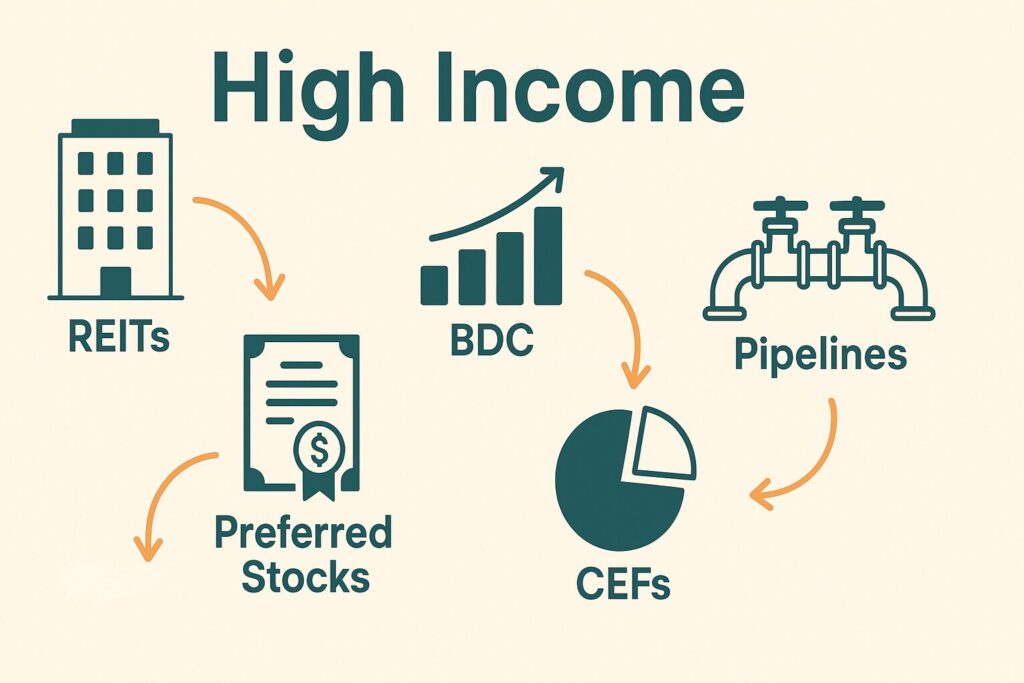
If you’re a retiree or soon-to-be retiree, you’ve probably noticed something unsettling about the traditional approach to retirement investing.
Stocks are unpredictable.
Bonds don’t pay enough.
And when markets get rocky—like they did in 2008, 2020, and 2022—both stocks and bonds can fall together.
That’s a scary prospect when you’re relying on your portfolio to generate income month after month.
Fortunately, there are retirement income alternatives that go beyond the old 60/40 stock-bond formula. These income-producing investments offer:
- Higher yields
- Steady monthly or quarterly payouts
- Lower correlation to the stock market
Let’s explore four of the best income alternatives: REITs, BDCs, MLPs, and Closed-End Funds—and how they can help you build a worry-free retirement paycheck.
1. Real Estate Investment Trusts (REITs)
REITs are companies that own income-producing real estate—everything from apartments and office buildings to warehouses and shopping centers. By law, they must pay out at least 90% of their taxable income as dividends.
Why REITs Are Great for Retirees:
- High Dividend Yields: Many REITs yield 4%–8% or more.
- Inflation Protection: Rents typically rise with inflation.
- Diversification: REITs have a low correlation with traditional stocks and bonds.
Types of REITs to Consider:
- Equity REITs: Own and operate properties.
- Mortgage REITs: Invest in loans and mortgages.
- Specialty REITs: Focus on data centers, healthcare, storage units, etc.
A Retiree-Friendly Option:
REIT ETFs like VNQ (Vanguard Real Estate ETF) or income-focused REITs such as Realty Income (O) are popular choices among income investors.
2. Business Development Companies (BDCs)
BDCs invest in small- and mid-sized private businesses that often can’t get traditional bank loans. In return, BDCs charge high interest rates and collect equity stakes.
Like REITs, BDCs must pay out 90% of their income to shareholders.
Why BDCs Are Great for Retirees:
- Yields Often Exceed 9%
- Monthly or Quarterly Income
- Low Stock Market Correlation: BDCs depend more on business lending than stock prices.
A Retiree-Friendly Option:
Look at diversified BDCs like Main Street Capital (MAIN) or consider the ETF BIZD, which holds a basket of top BDCs and spreads out the risk.
3. Master Limited Partnerships (MLPs)
MLPs are publicly traded partnerships, primarily in the energy sector. They own and operate infrastructure like pipelines, storage facilities, and refineries.
Their business model is based on volume, not commodity prices—making their cash flows more stable than you might expect.
Why MLPs Are Great for Retirees:
- Yields of 7%–10%+ Are Common
- Tax Advantages: Most distributions are considered return of capital, which reduces your tax bill.
- Less Sensitive to Market Swings: Pipeline operators, for instance, get paid regardless of oil prices.
A Retiree-Friendly Option:
You can invest through funds like AMLP (Alerian MLP ETF) or Tortoise Energy Infrastructure CEFs, which offer professional management and high monthly income.
4. Closed-End Funds (CEFs)
Closed-End Funds are professionally managed investment funds that trade on stock exchanges. Unlike mutual funds, they raise a fixed amount of capital and then trade like a stock.
Many CEFs specialize in income-focused assets—including bonds, preferred stocks, REITs, MLPs, and more.
Why CEFs Are Great for Retirees:
- Yields of 8%–10%+ Are Common
- Monthly Payouts
- Discount Opportunities: Many CEFs trade below their net asset value (NAV), giving you more income for your dollar.
A Retiree-Friendly Option:
Consider PIMCO Income Strategy Fund (PFL) or Eaton Vance Tax-Advantaged Global Dividend Fund (ETO)—both offer high yields and diversified holdings.
Real-Life Example: How Don and Linda Replaced Their Paychecks
Don and Linda, both in their early 70s, were frustrated with their investment options. Their CD rates were barely keeping up with inflation, and their bond funds were losing value. They didn’t want to risk more in the stock market, especially after watching their portfolio drop in 2022.
With the help of a financial advisor, they shifted part of their retirement savings into income alternatives:
- 25% into REITs
- 25% into BDCs
- 20% into MLPs
- 20% into high-yield Closed-End Funds
- 10% in cash for short-term needs
The result? Their new income portfolio generated over 8% annual yield, paid out monthly or quarterly—enough to cover their expenses and give them peace of mind.
Better yet, it wasn’t tied entirely to stock market ups and downs. They finally felt like they had a true “retirement paycheck.”
Key Benefits of These Alternatives
Let’s summarize what makes these alternatives so attractive for retirees:
✅ Higher Yields
Many traditional bonds yield just 3%–4%. These alternatives can pay 7%–10%+.
✅ Regular Income
Most of these investments pay monthly or quarterly—perfect for retirees looking for steady cash flow.
✅ Diversification
They often have lower correlation to traditional stocks and bonds, adding a layer of protection to your portfolio.
✅ Inflation-Resistant
REITs raise rents, MLPs benefit from growing energy demand, and BDCs adjust rates on their loans—helping you stay ahead of inflation.
Final Thoughts: It’s Time to Rethink Retirement Income
You don’t have to settle for low bond yields or nervously ride the stock market rollercoaster. There’s a better way to generate reliable, consistent income—and it starts with exploring income alternatives like REITs, BDCs, MLPs, and CEFs.
These strategies aren’t new—but they are often overlooked by retirees who only hear about stocks and bonds.
By diversifying with high-yield alternatives, you can:
- Boost your income
- Reduce your portfolio risk
- Sleep better knowing your retirement is on solid footing
This post is adapted from my book,
📘 9% Retirement Paycheck: How to Generate Steady, Worry-Free Income for Life
Available now on Amazon in paperback and eBook formats.
In the book, you’ll get step-by-step strategies, model portfolios, and easy-to-understand guidance on how to build a safer, higher-income retirement.
Disclaimer: This article is for informational and educational purposes only and does not constitute financial or investment advice. Always consult a licensed financial advisor or tax professional before making investment decisions. Past performance is not a guarantee of future results. Investing involves risk, including the possible loss of principal.